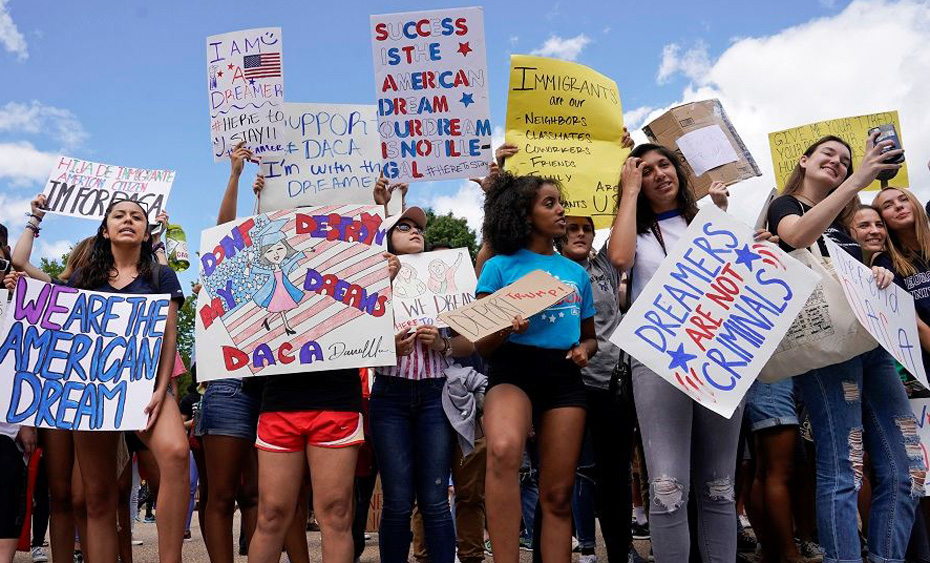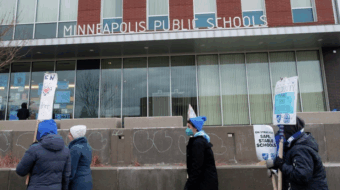
We have a hostage situation. Right here in the United States.
The hostage taker is holed up in the Oval Office of the White House. The hostages are 800,000+ Dreamers, young people brought to the United States without immigration papers when they were minor children. Former President Barack Obama offered them relief in the form of the “DACA” (Deferred Action for Childhood Arrivals) executive order of 2012. This allowed these young people to have Social Security numbers, to work, and to attend college while Congress supposedly worked on a permanent solution for their dilemma.
But Congress never did so, and on September 5, President Trump, who made xenophobic and racist anti-immigrant bigotry the central theme of his 2016 presidential election campaign, announced the imminent end of DACA. There will be a six-month transition period, lasting until March 2018, supposedly to allow Congress time to work out a legislative fix.
At the end of that period, DACA beneficiaries will apparently be ordered to leave the country, or will be targeted for arrest or forced deportation. This will break up families and destroy lives all over the country. Many of those deported could face violence and even death in the countries their families fled years ago.
A solid majority of people of the United States oppose such a cruel action, according to public opinion polls. But besides Trump’s own bigotry, there is the problem that the issue of what to do about undocumented immigrants is the favorite focus of U.S. Attorney General Jeff Sessions.
Supposedly, a deal was reached between the Democratic and Republican leaders in Congress, plus President Trump, whereby the DACA recipients, or Dreamers, would be provided a legislative solution that would let them stay in the country. Some sort of concessions would be made by the Democrats, entailing things such as a crackdown on other categories of undocumented immigrants.
The Dreamers themselves took a dim view of any tradeoff that would save their situation at the cost of making lives infinitely worse for other immigrants, including their own parents and other relatives. They spoke out forcefully on this at a press conference where Nancy Pelosi was to speak on September 18, denouncing the deal and shouting, “All of us or none of us.”
The demand, articulated by United We Dream and other immigrants’ rights organizations, became for Congress to pass a “clean” DREAM Act, that did not harm other immigrants while giving the Dreamers legal status. This principled stand of the Dreamers won a lot of respect nationally.
But Trump blew the negotiators of the so-called bipartisan deal out of the water on October 8 by issuing a new statement on what he would insist be in any legislation bringing relief for the DACA recipients. The document reads like an anti-immigration wish list compiled by the worst enemies of immigrant communities in the country.
It was, in all probability, compiled in consultation with the three anti-immigrant organizations initiated by Michigan ophthalmologist John Tanton: The Center for Immigration Studies, Federation for American Immigration Reform, and Numbers USA. These organizations have been campaigning for years, not only for a crackdown on undocumented immigrants, but for a sharp reduction even of legal immigration. Trump is planning to give them everything they want, using the dilemma of the DACA beneficiaries as leverage.
So a hostage situation has now been created, with the Dreamers as the hostages. In exchange for supporting relief for the Dreamers, Trump the hostage taker is demanding the following things, among others:
*Appropriation of money to build his favorite thing, the border wall.
*The return of unaccompanied minors who have been arriving without papers at the U.S.-Mexico border in increased numbers in recent years to their countries of origin, mostly in violence-wracked Guatemala, Honduras, and El Salvador.
*Sharp reduction of opportunities for refugees to come to the United States by cracking down on supposed abuse of the system by asylum seekers.
*Hiring 370 more immigration judges and 1,000 more government immigration attorneys so that unauthorized border-crossers can be kicked out more quickly.
*Increasing punishment for people who return after having been removed from the country.
*Cracking down on sanctuary cities.
*Authorizing and “incentivizing” states and cities to cooperate with federal immigration raids and related actions.
*Hiring 10,000 more immigration cops and 300 federal prosecutors to deal with immigration cases.
*Forcing state and local police to hold non-citizens beyond the point at which others would normally be released from custody.
*Preventing gang members from receiving immigration benefits (and the government gets to say who is and who isn’t a gang).
*Requiring employers to use E-Verify to verify the legal status of workers they hire.
*Changing the present system of issuing permanent resident visas to one that stresses people with higher education in the STEM (science, technology, engineering, and mathematics) fields, and ending the ability of people in the United States to legally bring relatives other than spouses and children into the country as legal immigrants.
Trump’s new directive would effectively end the status of the United States as the country where “huddled masses, yearning to breathe free” could come to start new lives. It also proves the case of the Dreamers, who have expressed fear that a tradeoff of relief for DACA beneficiaries may make the situation of other immigrants and would-be immigrants infinitely worse.
So they and other immigrants’ rights activists feel they no choice but to oppose such a deal and continue demanding a “clean” DREAM Act, i.e. a targeted DACA relief bill. In this stance, they are getting support, including from some members of the U.S. Congress and other political leaders.
But is it practical—since the Republicans control both Houses of Congress, the White House, and the Supreme Court—to be demanding wholly progressive legislation with no downside, no trade-offs?
Supporters of the “Clean DACA bill,” or “Clean Dream Act,” point to the fact that public opinion in the United States overwhelmingly sympathizes with the Dreamers and does not agree with harsh anti-immigrant policies.
Thus the action moves to the streets to try to mobilize that huge public opinion advantage in such a way as to put pressure on the government and Congress to back off and release the hostages.










